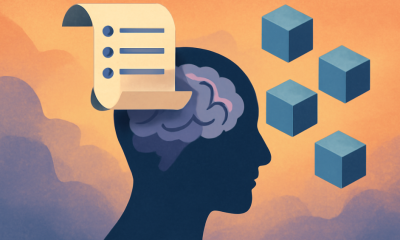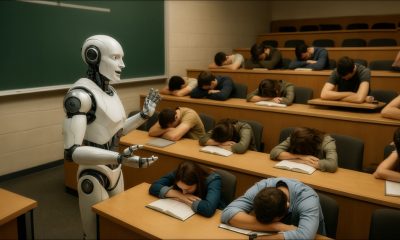Artificial Intelligence
MiniGPT-5: Interleaved Vision-And-Language Generation via Generative Vokens

Over the past few years, Large Language Models (LLMs) have garnered attention from AI developers worldwide due to breakthroughs in Natural Language Processing (NLP). These models have set new benchmarks in text generation and comprehension. However, despite the progress in text generation, producing images that coherently match textual narratives is still challenging. To address this, developers have introduced an innovative vision and language generation approach based on “generative vokens,” bridging the gap for harmonized text-image outputs.
The foundation behind MiniGPT-5 is a two-staged training strategy that focuses heavily on description-free multimodal data generation where the training data does not require any comprehensive image descriptions. Furthermore, to boost the model’s integrity, the model incorporates a classifier-free guidance system that enhances the effectiveness of a voken for image generation. In the initial phase, the MiniGPT-5 framework has demonstrated powerful performance and a substantial improvement over the baseline Divter model that is trained on the MMDialog dataset, and has constantly demonstrated its ability to deliver comparable & even superior multimodal outputs in the human evaluations performed on the VIST dataset that further highlights its performance & efficiency across various benchmarks.
MiniGPT5 : An Introduction
With the recent developments of the LLM frameworks, and applications based on these LLM frameworks, multimedia feature integration is a field that has witnessed a rise in its popularity as it also proves to be a vital advancement that powers a wide array of applications from state-of-the-art content creation tools to cutting-edge multimodal dialogue agent. With continuous research and development, language and vision models are at the point where work is going on to facilitate them to generate both text & visual data seamlessly. The ability of LLM to generate multimodal data seamlessly will help in enhancing interactions across different domains including e-commerce, media, and virtual reality.

Ultimately, the aim is to allow models to synthesize, recognize, and respond in a consistent & logical way using both textual & visual modalities, thus playing a crucial role in harmonizing the flow of information, and creating logical & consistent narratives. The need to achieve a blend of textual & visual modalities is fueled primarily by the need of more fluid, integrated & interactive multimodal interactions in LLMs, and ultimately achieving the alternating language and vision generation. However, achieving integrated & interactive multimodal interactions in LLMs is a complicated task riddled with numerous challenges including
- Although current LLM are extremely efficient & capable when it comes to text generation, and processing text-image pairs, they do not deliver satisfactory performance when it comes to generating images.
- The development of these vision and language models relies heavily on topic-focused data that makes it challenging for models to align the generated text with its corresponding images.
- Finally, there is a need to come up with more effective strategies as with an increase in their capabilities, the memory requirements of LLMs also increase especially when performing downstream tasks.
The MiniGPT-5 framework, an interleaved language & vision generating algorithm technique that introduces the concept of “generative vokens” in an attempt to address the challenges mentioned above. The MiniGPT-5 framework proposes a new approach for multimodal data generation by amalgamating Large Language Models with Stable Diffusion techniques by using special visual tokens. The proposed two-stage training method used by the MiniGPT-5 framework highlights the importance of a foundational stage free of descriptions, and preparing the model to deliver efficient performance even in scenarios with limited data.

But what separates the MiniGPT-5 model from current existing frameworks is that the generic stages of the MiniGPT-5 framework do not consist of domain specific annotations. Furthermore, to ensure that the generated text, and their corresponding images are in harmony with one another, the MiniGPT-5 framework deploys a dual-loss strategy that further enhances MiniGPT-5’s approach of using classifier-free guidance and generative vokens. The MiniGPT-5 framework optimizes training efficiency, and addresses the memory constraints thanks to their parameter-efficient strategy for fine tuning the model.
To provide you with a quick summary, the MiniGPT-5 framework
- Proposes a method that uses multimodal encoders that represent a novel & generic method that has historically proved to be more effective than traditional LLMs, and uses generative tokens combined with Stable Diffusion techniques to generate interleaved language & visual outputs.
- Proposes a dual-stage training strategy for generation of description-free multimodal output, and the inclusion of classifier-free guidance during training to further refine the quality of data generated.
The MiniGPT-5 model is inspired heavily from the previous research & work done in the fields of
- Text to Image Generation : To facilitate the transformation of textual descriptions into their respective visual representations, and text to image models.
- MLLMs or Multimodal Large Language Models : Using pre-trained LLM models to explore their applications & effectiveness in generating multimodal data.
- Multimodal Generation with Large Language Models : To augment the capabilities of a LLM to seamlessly integrate language & visual data generation.
MiniGPT-5 : Method, Architecture, and Framework
To facilitate large language models with multimodal data generation capabilities, the MiniGPT-5 model introduces a framework that aims to integrate text to image generation models and pretrained multimodal large language models. The MiniGPT-5 framework further introduces the “generative vokens”, special visual tokens that allows developers to address the discrepancies that appear across different domains by being able to train directly on raw images. To further enhance the quality of the multimodal data generated by the LLMs, the MiniGPT-5 framework introduces a classifier-free strategy coupled with an advanced two-stage training method. Let’s have a detailed look at the MiniGPT-5 framework.
MultiModal Input Stage
Developments of LLMs in the recent past have brought LLMs multimodal comprehension abilities to light, enabling processing images as a sequential input. The MiniGPT-5 framework makes use of specially designed generative vokens for outputting visual features in an attempt to expand LLMs multimodal comprehension abilities to multimodal data generation. Furthermore, the MiniGPT-5 framework makes use of parameter efficient and cutting edge fine tuning techniques for multimodal output learning with the LLM framework.
Multimodal Encoding
The pretrained visual encoder in the MiniGPT-5 framework transforms each input image into a feature, and each text token is embedded as a vector, and the input prompt features are generated when these embeddings are concatenated with one another.
Adding Vokens in Large Language Models
Traditionally, Large Language Model vocabulary consists only of textual tokens which is why the developers working on the MiniGPT-5 framework had to bridge the gap between the generative & the traditional LLMs. The MiniGPT-5 framework introduces a set of special tokens as generative tokens into the vocabulary of the LLM. The framework then harnesses the hidden output state of the LLM for these special vokens for subsequent image generation, and the insertion of interleaved images is represented by the position of the vokens.
PEFT or Parameter Efficient Fine Tuning
PEFT or Parameter Efficient Fine Tuning is a crucial concept used to train LLMs, and yet, the applications of PEFT in multimodal settings is still unexplored to a fairly large extent. The MiniGPT-5 framework uses the Parameter Efficient Fine Tuning over the encoder of the MiniGPT-4 framework in order to train the model to understand prompts or instructions better, and even enhancing the overall performance of the model in a zero-shot or novel environments.
Multimodal Output Generation
To align the generative model with the generative tokens accurately, the MiniGPT-5 framework formulates a compact mapping module for matching the dimensions, and incorporating supervisory losses including latent diffusion model loss, and text space loss. The latent diffusion supervisory loss aligns the appropriate visual features with the tokens directly whereas the text space loss helps the model learn the correct positions of the tokens. Because the generative vokens in the MiniGPT-5 framework are guided directly by the images, the MiniGPT-5 framework does not require images to have a comprehensive description, resulting in a description-free learning.
Text Space Generation
The MiniGPT-5 framework follows the casual language modeling method to generate both vokens and texts in the text space jointly, and during the training phase, the developers append the vokens to the position of the ground truth images, and train the model to predict vokens within text generation.
Mapping Voken Features for Image Generation
After generating the text space, the framework aligns the hidden output state with the text conditional feature space of the text to image generation model. The framework also supports a feature mapper module that includes a dual-layer MLP model, a learnable decoder feature sequence, and a four-layer encoder-decoder transformer model.
Image Generation with LDM or Latent Diffusion Model
To generate the required images in the denoising process, the framework uses the mapping features as a conditional input. The framework also employs a LDM or Latent Diffusion Model for guidance, as during the training phase, the ground truth image is first converted into a latent feature using a pre-trained VAE following which, the developers obtain the latent noise feature by adding some noise.
The comprehensive approach deployed by the MiniGPT-5 framework allows developers to have a coherent understanding, and generation of both visual and textual elements, using specialized tokens, leveraging the capabilities of pretrained models, and using innovative training techniques.
MiniGPT-5 : Training and Results
When working on the MiniGPT-5 framework, developers observed that training on a limited interleaved text-and-image dataset directly can result in images with diminished quality, and misalignment given the significant domain shift between the image & text domains. To mitigate this issue, developers adopted two distinct training strategies,
- Encompassing the incorporation of classifier-free guidance techniques that boosts the effectiveness of generative tokens during the diffusion process.
- The second strategy is further divided into two stages
- An initial pre-training stage that focuses primarily on aligning coarse features.
- A fine-tuning stage that facilitates feature learning.
CFG or Classifier Free Guidance
The idea to first leverage CFG for multimodal generation came as a result of an attempt to enhance consistency & logic between the generated images & texts, and the CFG is introduced during the text to image diffusion process. This method observes that by training on both unconditional and conditional generation with conditioning dropout, the generative model can achieve enhanced conditional results.
Two-Stage Training Strategy
Given the significant domain shift observed between text-image generation, and pure text generation, the MiniGPT-5 framework uses a two-stage strategy for training
- Unimodal Alignment Stage or UAS,
- Multimodal Learning Stage or MLS.
Initially, the framework aligns the image generation features with the voken feature in single text-image pair datasets where each data sample contains only one text, and only one image, and the text is usually the image caption. In this stage, the framework allows the LLM to generate vokens by utilizing captions as LLM inputs.
Once the UAS has executed successfully, the model can generate images for single text descriptions, but struggles with interleaved language and vision generation including text-image pairs, and complicated reasoning is required for image and text generation. To tackle this hurdle, the developers have further fine tuned the MiniGPT-5 framework using PEFT parameters by interleaved vision-and-language datasets like VIST. During this stage, the framework constructs three different tasks from the dataset
- Text Only Generation : Generates the related text given the next image.
- Image Only Generation : Generates the related image given the next text.
- Multimodal Generation : Generates text image pairs using the given context.
MiniGPT-5 : Benchmarks and Results
To evaluate its performance in multimodal generation comprehensively, the MiniGPT-5 development team compares its performance with other prominent baseline models including Divter, GILL, and the Fine Tuned Unimodal Generation Model, and the comparison is demonstrated in the table below.

The MiniGPT-5 framework understands that the multimodal output might be meaningful as per the context, yet it might differ from the ground reality which is the primary reason why the MiniGPT-5 framework also incorporates human inputs to evaluate & assess the performance of the model. Overall, the effectiveness of the MiniGPT-5 framework for multimodal tasks is measured using three perspectives.
- Language Continuity : assessing whether the generated content aligns with the provided context seamlessly.
- Image Quality : assessing or evaluating the relevance & clarity of the image generated.
- Multimodal Coherence : to determine whether the combined text image output is in sync with the initial context.
VIST Final Step Evaluation
In the first stage of experiments, the MiniGPT-5 framework aims to generate the corresponding images, and the table below summarizes the results obtained from this setting.

As it can be seen, the MiniGPT-5 framework in all the three settings can outperform the fine-tuned SD2 framework, thus highlighting the effectiveness of the MiniGPT-5 pipeline.

The figure above compares the performance of the MiniGPT-5 framework with the fine-tuned MiniGPT-4 framework on the S-BERT, Rouge-L and Meteor performance metrics. The results indicate that the use of generative vokens does not affect the performance of the framework negatively when performing multimodal comprehension tasks. The results also demonstrate that the MiniGPT-5 framework is capable of utilizing long-horizontal multimodal input prompts across a wide array of data to generate high-quality & coherent images without compromising the ability of the original model for multimodal comprehension.

The table above compares the performance of three frameworks on 5,000 samples for multimodal generation from the aspects of Multimodal Coherence, Image Quality, and Language Continuity. As it can be observed, the MiniGPT-5 framework outperforms the other two baseline models by more than 70% cases. On the other hand, the table below demonstrates the performance of the MiniGPT-5 framework on the CC3M validation dataset for the generation of single images. Thanks to data limitations, developers found a gap for voken alignment when used with Stable Diffusion. Despite this limitation, the MiniGPT-5 framework outperforms the current state of the art baseline GILL framework across all metrics.


Conclusion
In this article, we have talked about MiniGPT-5, an interleaved language & vision generating algorithm technique that introduces the concept of “generative vokens” in an attempt to harness the capabilities of LLMs to generate multimodal data y aligning the large language model with a text to image generation model that is pre-trained. We have talked about the essential components & the overall architecture of the MiniGPT-5 framework along with the results that indicate substantial improvements in performance & efficiency when compared with the current baseline & state of the art models. MiniGPT-5 aspires to set a new benchmark in the multimodal content & data generation domain, and aims to resolve the challenges faced by previous models when trying to solve the same problem.












